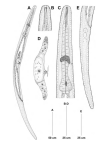 |
Females:
-
Body slender, slightly
ventrally curved, tapering garadually towards extremities.
-
Cuticle finely
annulated. Lateral fields inconspicuous.
-
Lip region continuous
with body contour.. Outer labial sensilla pore-like, cephalic sensilla
papilliform.
-
Amphidial apertures small
elliptical slits.
-
Stoma tubular, with small
cheilo- and gymnostom and long sclerotized tubular stegostom. Three
small denticles at anterior edge of stegostom; dorsal denticle slightly
larger than sub ventral denticles.
-
Pharynx cylindrical with
expanded basal bulb with thickened lumen/ valve plates.
-
Cardia small without
glandular cells.
-
Didelphic-amphidelphic; ovaries
outstretched.
-
Tail elongate-conoid,
tapering to a hemispherical terminus without a spinneret. Caudal glands
obscure
Male not seen.
Ref: Tahseen et al., 2012
|